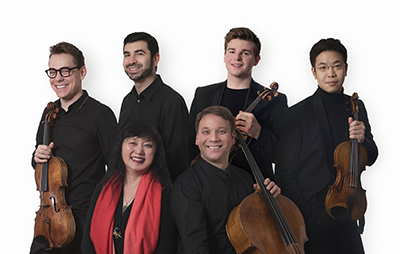by Daniel Hathaway

Those composers go well together: Brahms championed Dvořák’s career, and the two wrote music in similar formats, allowing Wu Han to curate a program each half of which began with a set of four-hand piano folk dances and ended with a piece for piano and strings.
Wu Han (at the bass end of TMA’s “Three Graces” Steinway) and Michael Brown (at the treble) began with scintillating performances of Dvořák Slavonic Dances selected from Op. 46 and 72. Because of their many short sections and repeats, these pieces are usually white-knuckle experiences for page turners, but here the pianists played from two iPads that had been synced for the occasion. Pages were flipped via a bluetooth pedal controlled by Wu Han, whose feet were colorfully decked out in bubble gum pink heels.
Brown stuck around, joined by Huang and Atapine in a luminous reading of Brahms’ Trio in c, Op. 101. Full of energy and purpose, the performance steered clear of the plummy tone that older players often bring to Brahms — adding an extra layer of expression to music that already contains plenty of embedded emotion.
Wu Han and Brown swapped ends of the piano for a set of Brahms Hungarian Dances, again bringing clarity and transparency to textures that can become too thick in performance.
The concert ended with an altogether satisfying reading of Dvořák’s Quintet in A, Op. 81, with Cleveland native Chad Hoopes on the first violin part and Matthew Lipman on the viola line. Lucid textures and palpable excitement were the rule, and the second movement Dumka (lament) and third movement Furiant, with its infectious, shifting rhythms, allowed the ensemble wide latitude for contrast.
Bravo to Lincoln Center for its intergenerational programming, a policy that raises all ships. Young players fresh out of conservatory these days have nothing to fear technically, but it’s great to have the voice of experience close at hand when it comes to interpretational matters. And who doesn’t get a welcome kick out of interacting with younger people? Especially when they show up for a gig wearing flashy socks — looking at you, Matthew Lipman!
Published on ClevelandClassical.com January 30, 2018.
Click here for a printable copy of this article

